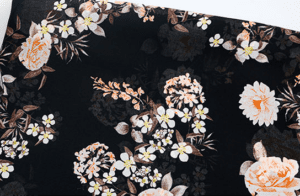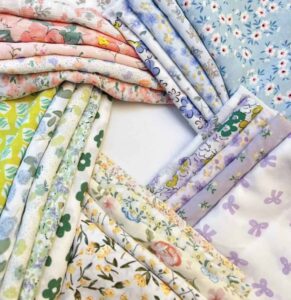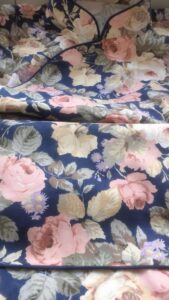Synthetic fibres are chemical fibres made from synthetic, linear polymers of suitable molecular weight and soluble (or fusible) properties, which are spun and shaped and post-treated. In contrast to natural and man-made fibres, the production of synthetic fibres is not restricted by natural conditions. In addition to the general superior performance of chemical fibres, such as high strength, light weight, easy to wash and dry, good elasticity, not afraid of mould and moth, etc., different varieties of synthetic fibres have certain unique properties.
Filament
In the manufacture of synthetic fibres, the spinning fluid (melt or solution) is spun into shape and post-processed to produce a kilometre-long fibre called a filament. Filaments include monofilaments, compound filaments and cord filaments. 01 Monofilaments
Originally refers to a continuous single fibre spun by a single-hole spinneret, but in practice often also includes 3 to 6 single fibres spun by a 3- to 6-hole spinneret consisting of fewer holes. The coarser synthetic monofilaments (0.08 to 2 mm in diameter) are called bristles and are used to make ropes, brushes, daily bags, fishing nets or industrial filter cloths; the finer polyamide monofilaments are used to make transparent women’s socks or other high-grade knitted products.
compound filaments
A strip of filaments consisting of dozens of single fibres. The compound filaments of chemical fibres are generally made up of 8 to 100 single fibres. The vast majority of fabrics are woven with multi-filaments because they are more flexible than monofilaments of the same diameter. 03 Cord filaments
A strip of filament consisting of more than 100 to several hundred single fibres used in the manufacture of tyre cord fabric, commonly known as cord yarn.
Short fibres
Chemical fibres are cut into lengths of a few centimetres to a dozen centimetres, and these lengths are called staple fibres. Depending on the length of the cut, staple fibres can be divided into cotton staple fibres, wool staple fibres and medium-length staple fibres. 01 Cotton staple fibres
Length of 25 ~ 38mm, the fiber is thin (line density of 1 .3 ~ 1 .7dtex), similar to cotton fibers, mainly for blending with cotton fibers, such as cotton polyester staple fiber and cotton fiber blending, the fabric called “polyester cotton” fabric. 02 wool staple fiber
Length of 70 ~ 150mm, thicker fibres (line density 3.3 ~ 7.7dtex), similar to wool, mainly used in blending with wool, such as with wool polyester staple fibres and wool blending, the fabric is called “wool polyester” fabric. 03 long fibres
Length of 51 ~ 76mm, fiber thickness between cotton and wool type (line density of 2 .2 ~ 3 .3dtex), mainly used for weaving medium and long fiber fabrics. In addition to blending with natural fibres, short fibres can also be blended with other chemical fibres, resulting in blended textiles with good overall performance.
In addition, staple fibres can also be spun pure. In the current production of chemical fibres worldwide, the production of short fibres is higher than the production of filaments. According to the characteristics of the fibres, some varieties (such as nylon) are mainly produced in filament; some varieties (such as acrylic) are mainly produced in short fibres; and some varieties (such as polyester) are relatively close to the proportion of both.
Coarse detail silk
Coarse detail yarns, referred to as T&T yarns, have alternating coarse and detailed sections that can be seen in their appearance and alternating shades of colour when the yarn is dyed. The coarse detail yarn is manufactured using the uneven drafting technique after spinning and forming, and the difference in the nature of the two parts of the yarn produced can be controlled during production. The coarse detail yarn has a low strength, high elongation at break, high heat shrinkage, good dyeability and is easy to process with alkali reduction, making it possible to develop textiles with unique properties. The physical properties of coarse detail yarns are related to factors such as the diameter ratio of the coarse detail. In general, coarse details have a high elongation at break and boiling water shrinkage and a low breaking strength and yield. Its strong shrinkage properties allow coarse detail yarns to be blended with other yarns to form heteroshrinkage blends. In addition, the coarse detail yarn is easily deformed in the coarse section and its low strength should be noted during the weaving and dyeing process. With the development of coarse detail silk production technology, some special coarse detail silk has appeared, such as shaped coarse detail silk, blended coarse detail silk, micro porous coarse detail silk and fine denier coarse detail silk, etc., which either have a special feel and style, or have a special suction, more for the development of high-end fabrics.
Shape-shifting yarn
Deformed yarns include all filaments and yarns that have undergone a deformation process, such as stretch and bulky yarns. Stretch yarns
Deformed filaments can be divided into two types: high-stretch and low-elastic yarns. Stretch yarns have good stretch and fluffiness, and their fabrics are close to woollen, silk or cotton fabrics in terms of thickness, weight, opacity, coverage and appearance characteristics.
Polyester stretch yarns are mostly used for clothing, nylon stretch yarns are suitable for the production of socks and polypropylene stretch yarns are mostly used for household fabrics and carpets. The main methods of deformation are false twist, air jet, hot air jet, stuffing box method and fugue method. 02 Texturised yarn
The thermal plasticity of polymer compounds is used to mix two synthetic fibres with different shrinkage properties in proportion to each other, and after heat treatment, the high-shrinkage wool forces the low-shrinkage wool to curl, making the mixed wool stretchable and fluffy, becoming a deformed yarn similar to wool. Currently, acrylic bulky yarns are the most produced and are used for knitted outerwear, underwear, wool, blankets, etc.
Differentiated fibres
Differentiated fibres are a foreign term, originating from Japan, and generally refer to fibre materials obtained by physical deformation or chemical modification on the basis of the original chemical fibres, which are significantly different from ordinary chemical fibres in appearance and quality. Differentiated fibres improve and enhance the performance and style of chemical fibres, as well as giving them new functions and properties, such as high water absorption, electrical conductivity, high shrinkage and dyeing properties.
As the main focus of differentiated fibres is to improve the simulation effect, comfort and protection, they are mainly used for the development of textiles that imitate wool, hemp and silk, but also for the development of textiles for decoration and technical textiles.
Shaped fibres
In the synthetic fibre spinning and forming process, the use of shaped spinning holes spun with non-circular cross-sectional fibres or hollow fibres called shaped cross-sectional fibres, referred to as shaped fibres. At present, there are dozens of different types of shaped fibres, with about 50% of the polyester, polyamide and polyacrylonitrile fibres on the market being shaped.
The diagram above shows the shape of the spout holes (top) and the corresponding fibre cross-section (bottom) used in the manufacture of several types of shaped fibres. It should be noted that the cross-sections of fibres obtained by wet spinning with round spout holes (e.g. viscose and polyacrylonitrile fibres) are also not square, but may be serrated, waist-shaped or dumbbell-shaped. Nevertheless, they are not called shaped fibres. The different cross-sections of shaped fibres have different properties and play different roles in the development of textiles. Compared to ordinary round fibres, shaped fibres have the following properties: 01 Lustre and feel
The lustre of the fibres is related to the cross-sectional shape of the fibres. Triangular and trefoil cross-section yarns have a shiny sheen, which improves the “aurora” phenomenon of round fibres. For example, blends of polyester or polyamide fibres with triangular cross-sections and other fibres have a shimmering effect and are suitable for the development of faux silk fabrics, faux woollen fabrics and many types of fleece fabrics. Flat, ribbon-shaped, dumbbell-shaped cross-section of synthetic fibres with hemp, antelope wool and rabbit fur and other fibres feel and lustre.
Polyester filaments with a pentagonal cross-section have a lustre similar to that of real silk, and at the same time resist pilling and have a good feel and coverage. The polygonal cross-section of the silk in addition to the shiny, covering power, soft feel, mostly used to make deformed silk knitted fabrics and socks, its short fibres for blending, made of a variety of imitation wool fabrics and blanket products. Rectangular section silk luster soft, and silk and animal hair luster close, its short fiber and cotton fiber blends with wool style, and blended with wool can be obtained luster chic fabrics. 02 mechanical properties, water absorption and dyeing properties
Shaped fibres are more rigid, resilience and coverage can also be improved, with a slight reduction in strength. In addition, shaped fibres have a larger surface area, which enhances their ability to transfer water and steam, and they dry quickly and dye well. 03 Pilling resistance, fluffiness and breathability
Fibres with a flat cross-sectional shape can significantly improve the pilling phenomenon, and the flatter, the better the effect, such as polyester and polyamide flat cross-sectional fibres blended with wool, the fabric is generally less likely to pilling. Shaped fibres usually have good fluffiness, fabric feel rich, warmth, and because of the increase in pores, so good breathability, with the increase in cross-sectional irregularity, its fluffiness and breathability has also improved. 04 Hollow fibre characteristics
Hollow fiber warmth and fluffiness is excellent, some hollow fiber also has special uses, such as the production of reverse osmosis membrane, used for artificial kidney, desalination, sewage treatment, hard water softening, solution concentration, etc.
Composite fibres
The presence of two or more unmixed polymers in the cross-section of the fibre, this chemical fibre is known as a composite fibre, or bicomponent fibre. As the two or more components contained in such fibres complement each other, the performance of composite fibres is usually better than that of conventional synthetic fibres and has a wide range of uses. There are many varieties of composite fibres, which can be divided into two main categories according to their form, namely double-layer and multi-layer types. The double-layer type also includes the parallel type and skin core type, multi-layer type including parallel multi-layer type, radiation type, multi-core type, wood grain type, embedded type, island type and cleavage type, etc..
The main characteristic of parallel composite fibres is high curl, which can make fabrics with fluffy, soft, warm performance and imitation wool style, mainly used in puffy wool, knitted fabrics, hosiery and blanket products. Skin-core composite fibres are also divided into eccentric skin-core type and concentric skin-core type two, the former has three-dimensional curl, but curl is not as good as the parallel composite fibres. Depending on the properties of the different polymers and their location in the cross-section of the fibres, many different properties and uses of composite fibres can be obtained. For example, the use of parallel compounding and partial skin-core compounding [see Figures (1), (2) and (4)], due to the different thermoplasticity of the two polymers or asymmetric distribution in the cross-section of the fibres, produces a shrinkage difference during post-processing, resulting in a spiral curl of the fibres, which can be made into a composite fibre with similar elasticity and fluffiness to wool. Skin and core composite fibres are both polymer characteristics or highlight a polymer characteristics of the fibre, such as nylon for the skin layer, polyester for the core layer, can be made into a good dyeing, feel soft in the fiber; the use of high refractive index of the core layer and low refractive index of the skin layer can be made into light guide fibres.
If the use of island component continuous dispersion in the sea component to form island-type composite fibres, and then solvent dissolution of the sea component, the remaining continuous island component, the production of very fine very fine fibres. The cleaved composite fibres appear as coarse filaments during spinning and post-processing. In the weaving process, especially in the finishing and wool grinding process, due to the compatibility of the two components and poor interfacial bonding, each thicker filament split into many filaments, the composite form is different, the cross-sectional shape and thickness of the cleaved fibres are also different, such as Figure (5) for the orange petal composite fibres, cleaved fibres cross-sectional triangle, Figure (6) for the lobe composite fibres, cleaved fibres become flat, cleaved composite Fibre production technology has been widely used in the manufacture of ultra-fine fibres.
Microfiber
As the thickness of a single fibre has a great impact on the performance of the fabric, so chemical fibres can also be classified according to the thickness of a single fibre (line density), generally divided into conventional fibres, fine denier fibres, ultra-fine fibres and very fine fibres. Conventional fiber linear density of 1.5 ~ 4 dtex. fine denier fiber linear density of 0.55 ~ 1.4 dtex, mainly for simulation of silk type of light or thick fabrics. Ultra-fine fibres with a linear density of 0.11 to 0.55 dtex can be produced by the two-component composite splitting method, the island method, meltblown method, etc. Very fine fibres with a linear density of 0.11dtex or less can be produced by the island spinning method and are mainly used in special fields such as artificial leather and medical filter materials.
Compared with conventional synthetic fibres, microfiber has the advantages of a soft and smooth feel, soft lustre, strong fabric coverage and good comfort, but also has poor wrinkle resistance, dyeing when the drawbacks of greater dye consumption. Its main properties are detailed in the table below. Microfiber is mainly used in the manufacture of high-density waterproof breathable fabrics, artificial leather, imitation suede, imitation peach skin velvet, imitation silk fabrics, high-performance rubbing cloth, etc.
New Hefei
In the late 1980s, New Synthetic Fibre emerged in Japan and became a global sensation with its new and unique supernatural style and texture, such as the feel of peach skin and ultra-fine powder. It is a new type of fibre material that is incomparable to natural and synthetic fibres, with new modification and compounding techniques used in all steps from polymerisation, spinning, weaving, dyeing and finishing to sewing. According to its commodity form, the new synthetic fibre mainly includes super fluffy, super drapey and super fine type, according to its feel can be divided into silk feel, peach skin feel, super fine powder feel and new wool feel. 01 Super fluffy type
Of all the synthetic fibres used, the most numerous are super fluffy and high quality fibres, almost all of which are made using heteroshrinkage blends or multi-phase blending techniques. In order to improve the fluffiness of fiber products, the development of high heat shrinkage polymer and low shrinkage potential self elongation filament, so that the fabric to obtain a better fluffy effect. 02 ultra-fine as a new combined fiber of ultra-fine fibers with a very low linear density, some varieties of linear density of 0.001dtex or less, mainly using composite spinning technology spinning from the very fine. The resulting peachskin fabrics have an ultra-soft and delicate feel, which is difficult to match with natural fibres. 03 Super drape
Super drape type fibres are made by adding inorganic microparticles to the spinning liquid and then reducing the amount of processing after spinning to eliminate the inorganic microparticles, resulting in the formation of numerous micro-pitches on the surface of the fibres. As a result of the reduced friction between the monofilaments, super drapable fibres have a super drape and a unique feel not found in natural fibres.
Dyeable synthetic fibres
Synthetic fibres, especially polyester fibres, poor dyeability, and difficult to dye dark colours, through chemical modification to improve its dyeability and dyeing depth can be improved and enhanced, this modified synthetic fibres are called easy to dye synthetic fibres, mainly including cationic dyeable polyester fibres, cationic deep-dyeing polyamide fibres and acid dyeable polyacrylonitrile fibres and polypropylene fibres, etc.. Dyeable synthetic fibres not only expand the range of fibres that can be dyed, reduce the difficulty of dyeing, but also increase the variety of textile colours.
High Performance Fibres
High performance fibers have a special physical and chemical structure, one or more performance indicators significantly higher than ordinary fibers, and the acquisition and application of these properties are often related to astronautics, aircraft, marine, medical, military, fiber optic communications, bioengineering, robotics and large-scale integrated circuits and other high-tech fields, so high performance fibers are also known as high-tech fibers. High performance fibres are often distinguished by their special properties, such as high strength and high modulus, high absorbency, high elasticity, high temperature resistance and flame retardancy, light conduction, electrical conductivity, efficient separation, radiation protection, reverse osmosis, corrosion resistance, medical and pharmaceutical fibres and many other fibre materials. High performance fibres are mainly used in the manufacture of technical textiles, but some of them can also be used in the development of textiles for decoration and textiles for use, and the performance of these two types of textiles can be significantly improved and enhanced.
Nanofibres
Fibres with a diameter of less than 100 nm are commonly referred to as nanofibres (1 nm equals 10 m, i.e. 10 μm, the length of just 10 hydrogen atoms in a row), and some people now refer to fibres with nanoscale (i.e. particle size less than 100 nm) powder fillers as nanofibres. At present, the finest nanofibres are single carbon atom chains, and these carbon nanotubes are known as the king of nanomaterials because of the miraculous properties of this material, which is so fine that it is difficult to observe with ordinary instruments: ultra-high strength, ultra-flexibility and strange magnetism. It is 100 times stronger than steel, 200 times stronger than ordinary fibres, and only 1/6th as dense as steel. It has exotic conductivity, both metallic and semiconducting, and even different parts of a carbon nanotube can show different conductivity due to structural changes. The use of carbon nanotubes as rectifiers could replace silicon chips and thus lead to major changes in electronics, allowing computers to be made extremely small. Nanodevices made from carbon nanotubes can be used to assemble nanorobots, i.e. mosquito planes, ant tanks, etc., which can be used in military and medical applications. Carbon nanotubes can be used to make hydrogen storage materials and to develop hydrogen as a clean energy source for human services. In addition, carbon nanotubes can be used as invisible materials, catalyst carriers and electrode materials. Nanofibres can support the arrangement of ‘nano-machines’ and link integrated arrangements of ‘nano-machines’ into large-scale systems. The physical and chemical properties of most materials at nanoscale fineness are unconventional, for example: 01 surface effect
The smaller the size of the particles, the larger the surface area. As the surface particles lack the coordination of adjacent atoms, the increase in surface energy is extremely unstable and it is easy to combine with other atoms, showing a strong activity. The relationship between the diameter of a fibre and its specific length and surface area after reaching the nanoscale is shown in the table below. 02 Small size effect
When the size of a particle is small enough to be similar to or smaller than the wavelength of light waves, the de Broglie wavelength of conduction electrons and the coherence length or transmission depth of superconducting states, its periodic boundary conditions will be broken and the acoustic, optical, electromagnetic and thermodynamic properties of the particle will be changed, such as melting point reduction, colour separation, UV absorption, shielding electromagnetic waves, etc. 03 Quantum size effect
When the size of the particle is small to a certain value, the electron energy level near the Fermi energy level will change from quasi-continuous to discrete energy level, at this time, the original conductor of matter may become an insulator, the original insulator may become a superconductor. 04 macroscopic quantum tunneling effect
The tunneling effect is the ability of tiny particles to pass through an object under certain circumstances, as if there were a tunnel inside. The manufacture of nanofibres can be divided into 3 main categories: molecular technology, spinning and bioprocessing.
























